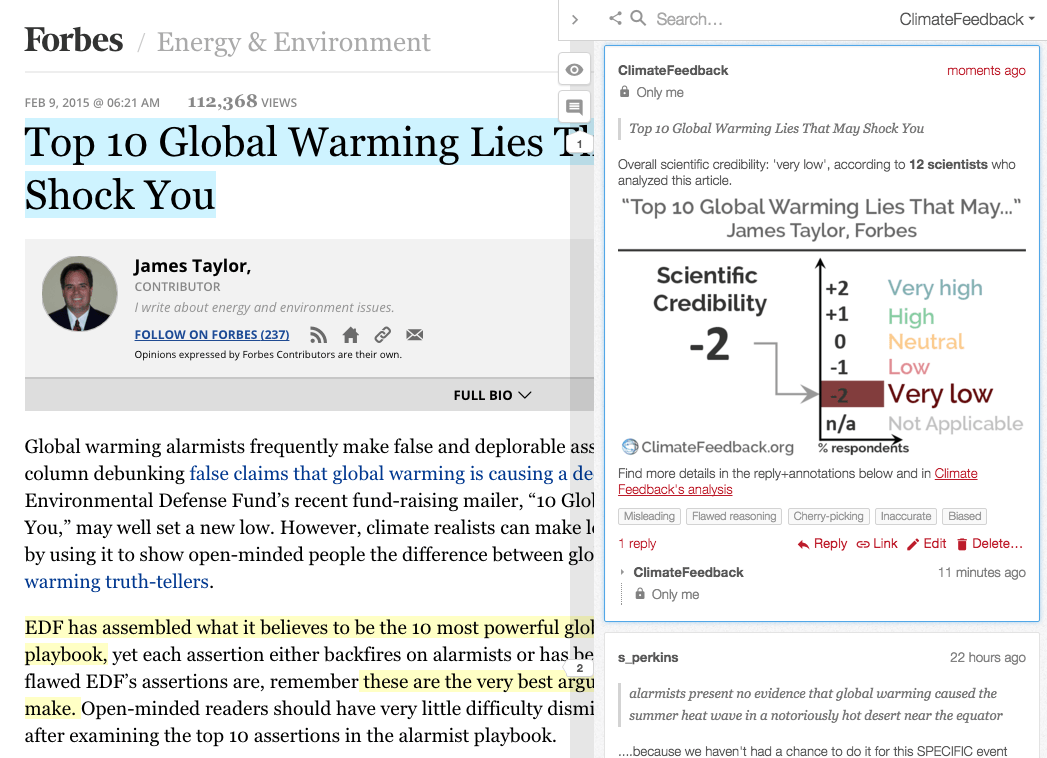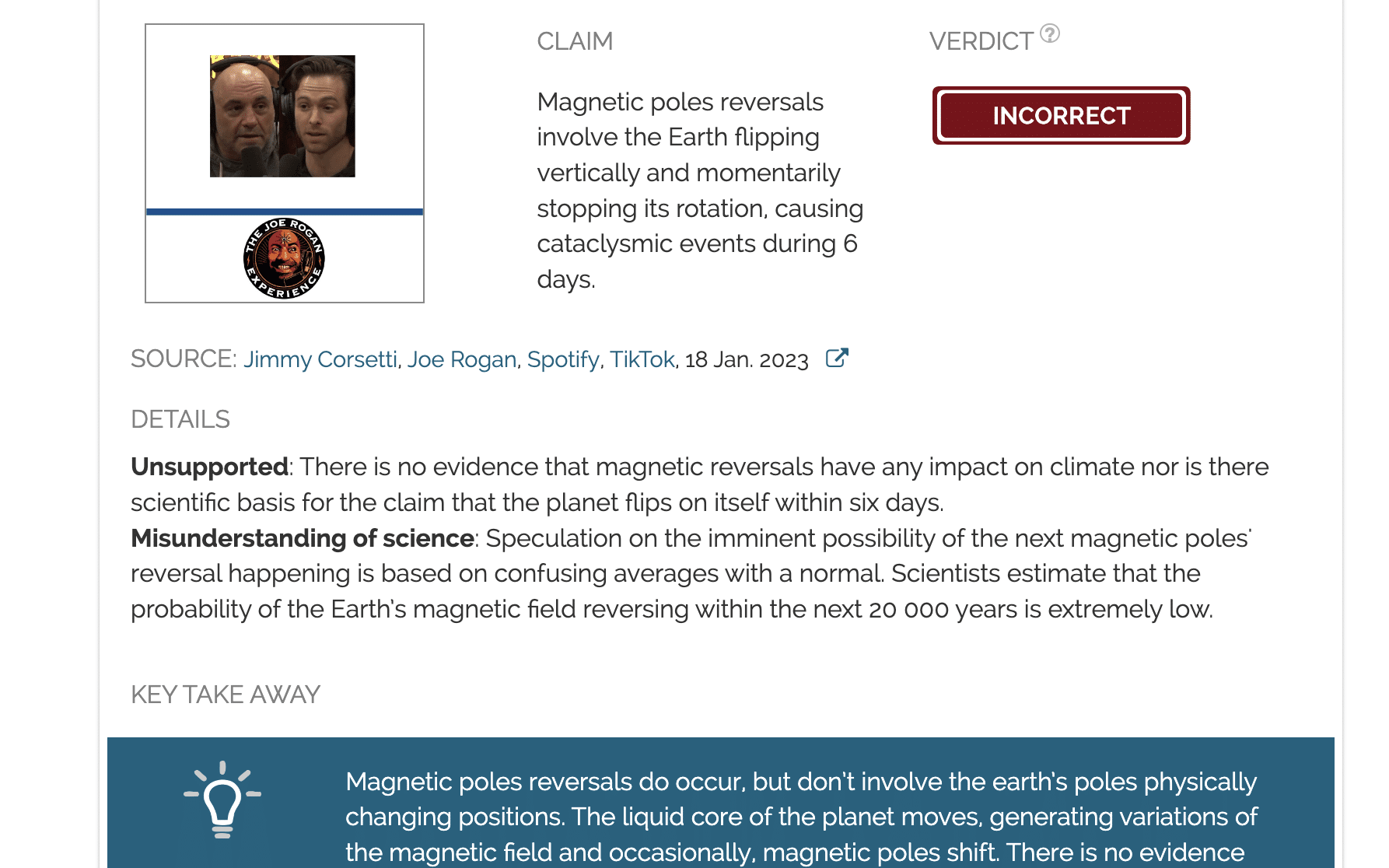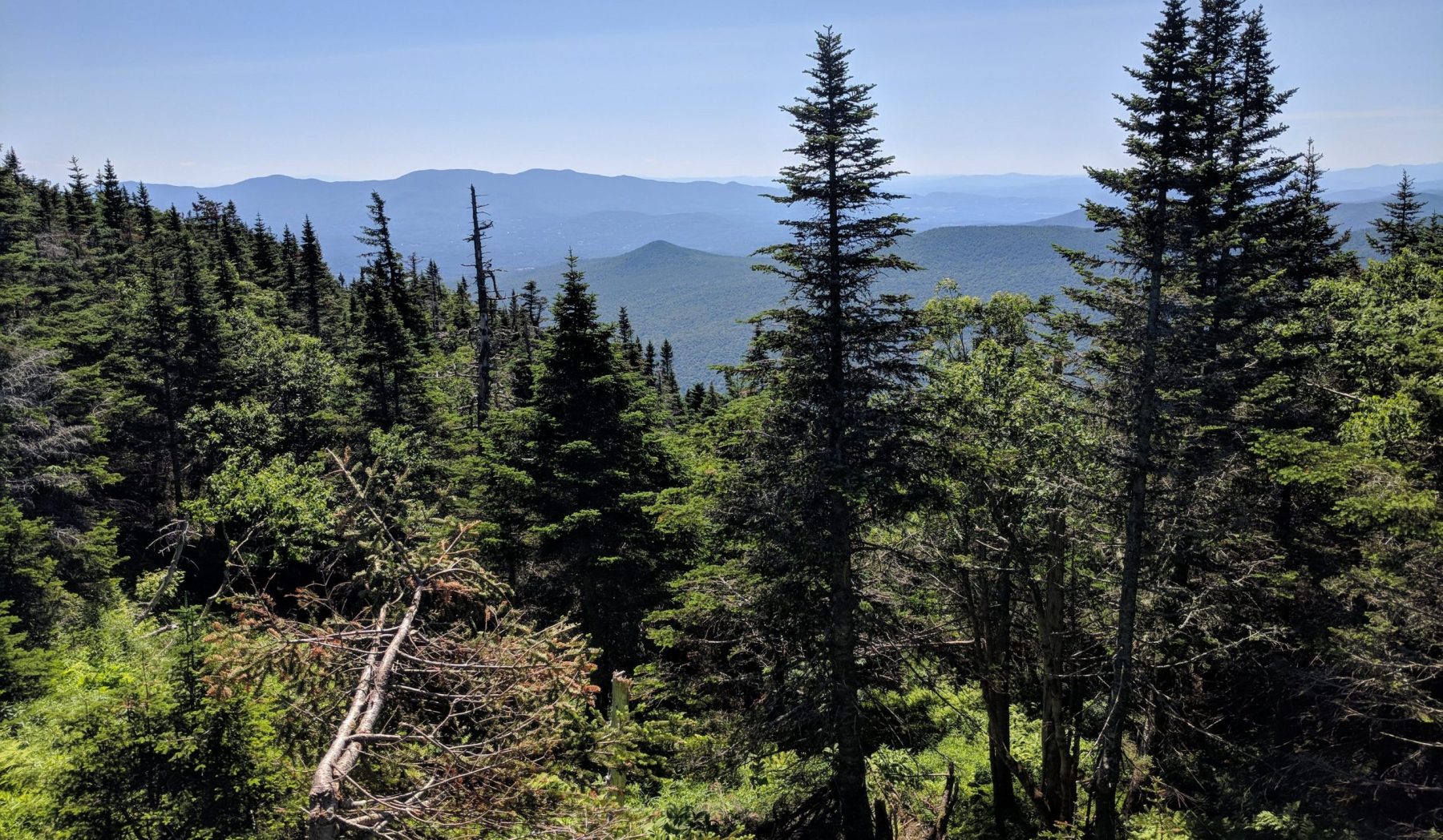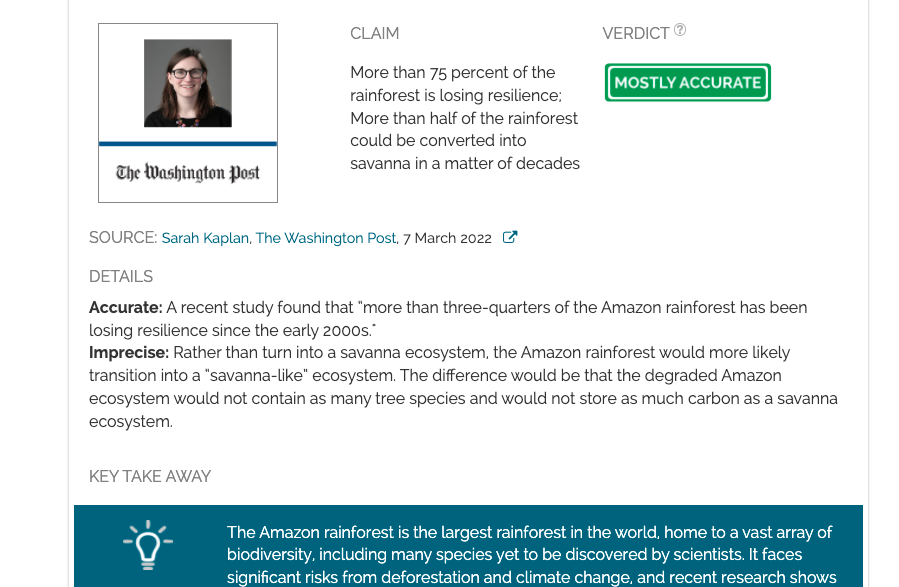- Climate
Analysis of “Top 10 Global Warming Lies That May Shock You”
Scientists’ Feedback
SUMMARY
According to Forbes.com, this article has been read more than 110,000 times, making it one of Forbes’ most read article on climate in 2015, and author James Taylor is a popular contributor who writes about energy and environment. So how accurate was this article?
Not accurate at all. According to scientists, this article contains numerous factual mistakes and flawed logic about basic science, and the reporting is based on uncredible sources. See the list below for more.
See all the scientists’ annotations in context
If the link does not work due to the high number of ads on Forbes, install Hypothesis bookmarklet or extension in your browser and switch it on from the article page.
GUEST COMMENTS
Peter Reich, Regents Professor and Distinguished McKnight University Professor in Forest Resources, University of Minnesota
This is an unusual (as well as misleading) article in that the author mixes sound scientific reasoning with illogical reasoning, and includes patterns and notions supported by data (i.e., facts) with ideas that are wildly inconsistent with the available evidence (falsehoods presented as facts). The misleading aspect comes in because the author picks what are presented as “facts” (sometimes accurate sometimes not accurate whatsoever) and compares these with other “facts” to make a point, but the comparison often has no real relevance to the questions or issues at hand.
David Bahr, Associate Professor, Department of Physics, Regis University and Institute of Arctic and Alpine Research, University of Colorado
I have rarely read such a misleading and factually inaccurate article. This is not science journalism and has no place in a magazine that purports to be a leading source of reliable news. It cannot qualify as an informed or informative opinion piece, and Forbes does their readers a great disservice by allowing the publication of blatant falsehoods.
The author -James Taylor- has no understanding of the important distinctions between polar sea ice (floating on an ocean) and polar ice sheets (grounded on land), and he confuses their role in sea level rise. Despite Taylor’s protestations, the temporary expansion of Antarctic sea ice (which the author embarrassingly confuses with the expansion of an ice sheet) is well understood in the context of climate change, as is the significant reduction of Arctic sea ice which the author misleadingly understates.
Taylor wrongly equates the existence of Antarctic sea ice with a lack of sea level rise. In fact, floating and melting sea ice cannot contribute to sea level rise, any more than floating and melting ice cubes can cause a glass of water to overflow. By erroneously focusing on sea ice, the author misdirects the reader and thereby conveniently overlooks the two largest current contributors to sea level rise, thermal expansion of oceans and melting glaciers. Mountain glaciers in particular (including those in Glacier National Park as discussed by Taylor) are receding at an unprecedented and increasing rate that has been repeatedly and undeniably linked to man-made climate change. The glaciers’ rapidly increasing contribution to sea level rise is unassailable.
Taylor makes numerous unsubstantiated and entirely non-scientific value judgements about the benefits of climate change, and then he very inappropriately presents these value judgements as logical evidence. Among many egregious examples, the author touts the unproven benefits of increased plant growth as glaciers recede. This is in contrast, for example, to peer-reviewed research showing that as glaciers melt there will be a loss of fresh drinking water to a significant percentage of the world’s population. Taylor’s uncorroborated value judgements should not be presented as if they are on equal footing with facts, and this is a very misleading tactic hiding behind his so-called presentation of science.
I could go on at length about the numerous falsehoods, misrepresentations, misdirections, cherry-picked data, cherry-picked research, and appalling logic in this article, but this sampling is sufficient to demonstrate Taylor’s failure to understand and competently write about climate change.
REVIEWERS’ OVERALL FEEDBACK
These comments are the overall opinion of scientists on the article, they are substantiated by their knowledge in the field and by the content of the analysis in the annotations on the article.
This article wins the Olympic gold for cherry-picking data, misleading claims, and a long list of scientifically unsupported assertions.

Research Scientist, Climate Change Research Centre, The University of New South Wales
Absolutely appalling. Not based on credible scientific publications. Cherry picking of data and results. Use of incorrect or ambiguous language to confuse reader and to support cherry-picked results.
This is a deeply flawed article, scientifically. The author tries to refute a document by the Environmental Defense Fund listing 10 effects of global warming that may be unexpected (“shocking”) to the layman. To do so, he uses logical fallacies, cherry-picks studies and/or data, makes unsubstantiated claims and generally completely ignores the science of climate change and its impacts on natural and human systems.

Associate Professor, Stanford University
Repeatedly makes the erroneous argument that if something is getting better overall (e.g. health, or food production), then it’s not possible that some factor (e.g. climate) could have a negative effect. By that logic, the readers of Forbes would only worry about the economy after it was already shrinking.

Postdoctoral research fellow, University of Innsbruck
In the sections of my expertise (glaciers, sea-level rise) the article bases its arguments on fundamental misunderstandings of basic science.
The difference between sea ice made from freezing sea water, and icebergs discharged from land ice (ice sheets and glaciers) is critical. The former has no impact on sea level, while the latter does.
Its a great example of where it is important to understand what the terminology refers to, and also why public articles ought to include definitions of these things to remove all ambiguity.

Professor, University of New South Wales
False claims made in this article include (just to name a couple in “Lie #1”): Australia’s highest recorded temperature being >50 years ago (this Oodnadatta reading was an incorrectly logged, and was invalidated by the Bureau of Meteorology); heat waves not being attributable to global warming (several recent studies have shown precisely that they are, in the sense that such severe heat could not have occurred without the boost from human-caused global warming).
Some claims (e.g. that we’ll just adapt to continued sea level rise) are as lacking in any scientific bases as the claims the author elsewhere criticises.

Climate Scientist, Environmental Defense Fund
Incredibly misleading article that takes information out of context and employs flawed reasoning. This article reveals without a doubt that the author is certainly no scientist or expert on the subject, and as such should not be considered a viable source of information.

Associate Director of the Center for Health and the Global Environment, Boston Children’s Hospital, Harvard
A reader could be fooled into believing what is written at face value but most claims articulated in James Taylor’s article are false based upon scientific research.

Senior scientist, The Norwegian Meteorological institute
Using labels such as “alarmist” does not invite to constructive debate. Furthermore, the statement “remember these are the very best arguments global warming alarmists can make” is highly subjective and not a judgement I think James Taylor is in position to make. For instance “Bats Drop from the Sky” is not one of them!
This article simply ignores the essential principles of good scientific journalism: Truth and accuracy, independence, and impartiality. The article is plagued with inaccurate information and false statements about climate and glacier change.
Notes:
[1] See the rating guidelines used for article evaluations.
[2] Each evaluation is independent. Scientists’ comments are all published at the same time.
Featured Annotations
Below is a list of scientists’ comments replying to James Taylor’s statements.
“Global warming alarmists’ preferred electricity source – wind power – kills nearly 1 million bats every year (to say nothing of the more than 500,000 birds killed every year) in the United States alone. […] Killing 30 million bats every year in response to dubious claims that global warming might once in a great while kill 100,000 bats makes no sense.”

Research Associate, Harvard University
False dichotomy. The point of transitioning power generation away from fossil fuels is not only to save bats. Also, just to provide some context, it is “estimated that between 89 and 340 million birds die annually from vehicle collisions on U.S. roads”
Australian bats are fine tuned to a specific threshold – around 42C. Once the temperature is reached they literally DO fall out of trees, and it is primarily lactating mothers and babies this happens to. The more this occurs (as what is projected under anthropogenic climate change), the more they will die, and the less they will be able to recover from what was once a very rare event.
See this article, and publications by the author Just Welbergen.
“Australia’s highest recorded temperature occurred more than half a century ago, … Indeed, Queensland’s 2014 heat wave paled in comparison to the 1972 heat wave that occurred 42 years of global warming ago. If global warming caused the 2014 Queensland heat wave, why wasn’t it as severe as the 1972 Queensland heat wave?”

Research Associate, Harvard University
Comparing particular dates in times and claiming that global warming should explain everything is a stale and discredited tactic from climate skeptics. What one needs to do is look at robust trends in the data. In his case, it shows that heat waves have increased in frequency/duration since 1950 in some parts of the world (where there is sufficient data to look at such changes), like Europe, Asia, and, yes, South-east Australia. See: Perkins, Alexander & Nairn (2012), Increasing frequency, intensity and duration of observed global heatwaves and warm spells, Geophys. Res. Lett.
“Lyme Disease is much more common in northern, cooler regions of the United States than in southern, warmer regions. Asserting, without any supporting data or evidence, that a disease that prospers in cool climates will become more prevalent as a result of global warming defies objective data and common sense.
Prof. Kristie L. Ebi, University of Washington:
The supporting evidence is one 2008 review of the spatial dynamics of Lyme disease by Killilea et al. The authors did conclude that the presence of forests was associated with increased risk of Lyme disease. They also concluded that the reasons for variations across forested areas are poorly understood, and that significant progress is needed in identifying the determinants of spatial variation in risk and incidence.
Between the year 2000 and 2015, there has been 31 publications on Lyme disease and climate change providing significantly more information. The recent US National Assessment Health Chapter concluded that: “Potential impacts of climate change on the transmission of Lyme disease include: 1) changes in the geographic distribution of the disease due to the increase in favorable habitat for ticks to survive off their hosts; 2) a lengthened transmission season due to earlier onset of higher temperatures in the spring and later onset of cold and frost;”
Susan E. Pacheco, MD, University of Texas Health Science Center at Houston:
1. That Lyme disease occurs in the northeastern states does not mean that the disease process is driven by a cold environment. Indeed the ticks that spread this disease thrive in humid and relatively warm environments. This, combined with increased human outdoor activities during warmer months help explain most cases of Lyme disease occur in the summer months. It has been established that the geographic distribution of the Ixodes tick has increased with warming temperatures.
2. The authors cite an article by Killilea et al, where it is stated, in the context of spatial dynamics, that “the only environmental variable consistently associated with increased Lyme disease was the presence of forests”. This is taken out of context as climate change is not a variable in this analysis. In a more recent article, Ostfeld, the senior author of the Killilea paper, discusses the association between climate warming and increase in the distribution of the Ixodes tick.
“The alarmists’ asserted national security threat depends on assertions that (1) global warming is causing a reduction in food and water supplies and (2) migrations of people to places with more food and water will increase risks of military conflict. Objective facts refute both assertions.”

Associate Director of the Center for Health and the Global Environment, Boston Children’s Hospital, Harvard
For starters, many experienced leaders—military, political, and otherwise—are extremely concerned about the threat climate change poses to security. See the American Security Project’s work on climate security.
In addition, growing staple crops at higher CO2 reduces their nutritional value.
While some regions have benefited from recent warming, extreme events associated with climate change have already destabilized the world food system. Models consistently show that climate change will adversely effect crop output.
The best available science also shows that even in the past few decades climate change has reduced food production, by as much as 5 billion dollars per year as of 2002.
“U.S. Forest Service data show pine beetle infestations have recently declined dramatically throughout the western United States.”

Associate Professor, University of Utah
This is true, but it does not reflect a lack of climate change influence on beetles. When one actually examines the US Forest Service reports data, they state that the infestation rates are falling in many regions because they have already killed most of their host pine species. This is hardly good news.
Regents Professor Steven W. Running, University of Montana:
Climate change has accelerated insect epidemic mortality in western forests. I would refer readers to the 2014 National Climate Assessment, specifically the Chapter on Forests for full details.
“Severe storms, floods and agricultural losses may cost a great deal of money, but such extreme weather events—and their resulting costs—are dramatically declining as the Earth modestly warms.”

Founder & Executive Director, Science Feedback
To the best of my knowledge, there is no scientific evidence showing that severe storms and flood are “dramatically declining“. Such a strong statement should be supported by a strong reference.
To the contrary, as the atmosphere warms, water vapor content increases, and this is allowing more extreme rainfall events, notably during hurricanes.
see eg: Trenberth (2011) Changes in precipitation with climate change
“Calling attention to anecdotal incidents of icebergs breaking off the Antarctic ice sheet, while deliberately ignoring the overall growth of the Antarctic ice sheet is a misleading and favorite tactic of global warming alarmists”
Martin Truffer, Professor, University of Alaska Fairbanks:
The author does not know what he is referring to when he says ‘the Antarctic Ice Sheet’. What has been expanding is the extent of sea ice around Antarctica, not the Antarctic Ice Sheet. While icebergs routinely break off Antarctica, the release of this particular iceberg was significant. Iceberg calving from Pine Island Glacier has been occurring at ever increasing rates, and the line of contact between the glacier and the ocean (the grounding line) keeps retreating. It looks even worse at nearby Thwaites Glacier that is now on the brink of unstable retreat, or has already crossed that threshold. See, for example: Joughin et al (2014). Marine Ice Sheet Collapse Potentially Underway for the Thwaites Glacier Basin, West Antarctica.
The basins of Thwaites and Pine Island Glacier hold enough ice to raise global sea level by 1.5 m.
“alarmists here are taking overwhelmingly good news about global warming improving plant health and making it seem like this good news is actually bad news because healthier plants mean more pollen.”
Susan E. Pacheco, MD, University of Texas Health Science Center at Houston:
1. There is definite scientific evidence demonstrating that warmer temperatures and higher CO2 levels increase the length of the pollen season, and the allergenicity of pollens.
2. Elevated pollen counts have been associated with increase in emergency room visits in patients with asthma.





